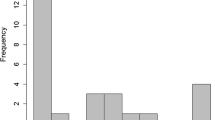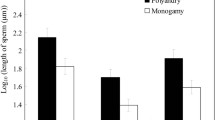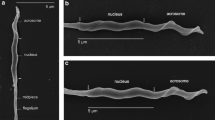Abstract
The evolutionary forces that shape and maintain variation in sperm traits across species in birds have recently attracted increased attention. Much less is known about the patterns, the causes and the consequences of variation in sperm traits within and, in particular, between populations of the same species. We here analyse intraspecific variation in sperm dimensions within and between two populations of the Coal Tit Periparus ater, a socially monogamous passerine with a high frequency of extra-pair paternity. Spermatozoa from a Norwegian population had a greater mean total length compared to those from a German population, mainly as a result of longer sperm heads. Sperm head length in the Norwegian population also accounted for a larger percentage of sperm total length suggesting differences in sperm proportions between populations. Furthermore, spermatozoa from the Norwegian population showed lower mean within-male variation in sperm length and there was significant between-male variation in sperm total length within each of the two populations. We discuss these results in the light of recent comparative evidence suggesting relationships between sperm length, and variation in sperm length, and the frequency of extra-pair paternity across passerine birds.
Zusammenfassung
Die evolutionären Kräfte, die die Variation von Spermienmerkmalen im zwischenartlichen Vergleich geformt und aufrechterhalten haben, erfuhren in jüngerer Zeit gesteigerte Aufmerksamkeit. Viel weniger ist jedoch über die Muster, die Ursachen und die Konsequenzen von innerartlicher Variation von Spermienmerkmalen bekannt, was insbesondere für die Variation zwischen Populationen einer Art gilt. Wir analysieren in diesem Beitrag innerartliche Variation in der Spermienmorphologie der Tannenmeise Periparus ater, einer sozial monogamen Singvogelart mit hohen Fremdvaterschaftsraten. Die Spermatozoen einer norwegischen Population waren im Mittel länger als die einer deutschen Population, was hauptsächlich auf längere Spermienköpfe zurückgeführt werden konnte. Die Spermienköpfe in der norwegischen Population machten auch einen größeren Anteil an der gesamten Spermienlänge aus, was auf Unterschiede in den Spermienproportionen schließen lässt. Darüber hinaus zeigten die Spermatozoen aus der norwegischen Population eine im Mittel niedrigere Variabilität innerhalb eines Ejakulats und die Spermienlänge unterschied sich signifikant zwischen individuellen Männchen in beiden untersuchten Populationen. Wir diskutieren diese Ergebnisse im Lichte aktueller vergleichender Studien, die Zusammenhänge zwischen Spermiengröße bzw. Variation in der Spermiengröße und der Häufigkeit des Auftretens von Fremdvaterschaften nahe legen.

Similar content being viewed by others
References
Becker WA (1992) Manual of quantitative genetics, 5th edn. Academic, Pullman, WA
Birkhead TR, Fletcher F, Pellatt EJ, Staples A (1995) Ejaculate quality and the success of extra-pair copulations in the zebra finch. Nature 377:422–423
Birkhead TR, Hosken DJ, Pitnick S (2009) Sperm biology—an evolutionary perspective. Academic, Oxford
Briskie JV, Montgomerie R, Birkhead TR (1997) The evolution of sperm size in birds. Evolution 51:937–945
Calhim S, Immler S, Birkhead T (2007) Postcopulatory sexual selection is associated with reduced variation in sperm morphology. PLoS ONE 2:e413. doi:https://doi.org/10.1371/journal.pone.0000413
Dietrich V, Schmoll T, Winkel W, Epplen JT, Lubjuhn T (2004) Pair identity—an important factor concerning variation in extra-pair paternity in the coal tit (Parus ater). Behaviour 141:817–835
Griffith SC, Owens IPF, Thuman KA (2002) Extra pair paternity in birds: a review of interspecific variation and adaptive function. Mol Ecol 11:2195–2212
Helfenstein F, Szép T, Nagy Z, Kempenaers B, Wagner RH (2008) Between-male variation in sperm size, velocity and longevity in sand martins Riparia riparia. J Avian Biol 39:647–652. doi:https://doi.org/10.1111/j.1600-048X.2008.04450.x
Immler S, Calhim S, Birkhead TR (2008) Increased postcopulatory sexual selection reduces the intramale variation in sperm design. Evolution 62:1538–1543. doi:https://doi.org/10.1111/j.1558-5646.2008.00393.x
Immler S, Pryke SR, Birkhead TR, Griffith SC (2010) Pronounced within-individual plasticity in sperm morphometry across social environments. Evolution 64:1634–1643. doi:https://doi.org/10.1111/j.1558-5646.2009.00924.x
Kleven O, Laskemoen T, Fossøy F, Robertson RJ, Lifjeld JT (2008) Intraspecific variation in sperm length is negatively related to sperm competition in passerine birds. Evolution 62:494–499. doi:https://doi.org/10.1111/j.1558-5646.2007.00287.x
Kleven O, Fossøy F, Laskemoen T, Robertson RJ, Rudolfsen G, Lifjeld JT (2009a) Comparative evidence for the evolution of sperm swimming speed by sperm competition and female sperm storage duration in passerine birds. Evolution 63:2466–2473. doi:https://doi.org/10.1111/j.1558-5646.2009.00725.x
Kleven O, Laskemoen T, Lifjeld JT (2009b) Sperm length in sand martins Riparia riparia: a comment on Helfenstein et al. J Avian Biol 40:241–242. doi:https://doi.org/10.1111/j.1600-048X.2009.04766.x
Laskemoen T, Kleven O, Fossøy F, Lifjeld JT (2007) Intraspecific variation in sperm length in two passerine species, the bluethroat Luscinia svecica and the willow warbler Phylloscopus trochilus. Ornis Fennica 84:131–139
Laskemoen T, Kleven O, Fossøy F, Robertson RJ, Rudolfsen G, Lifjeld JT (2010) Sperm quantity and quality effects on fertilization success in a highly promiscuous passerine, the tree swallow Tachycineta bicolor. Behav Ecol Sociobiol 64:1473–1483. doi:https://doi.org/10.1007/s00265-010-0962-8
Lessels CM, Boag PT (1987) Unrepeatable repeatabilities: a common mistake. Auk 104:116–121
Lubjuhn T, Gerken T, Brün J, Epplen JT (1999) High frequency of extra-pair paternity in the coal tit. J Avian Biol 30:229–233
Lüpold S, Calhim S, Immler S, Birkhead TR (2009a) Sperm morphology and sperm velocity in passerine birds. Proc R Soc Lond B 276:1175–1181. doi:https://doi.org/10.1098/rspb.2008.1645
Lüpold S, Linz GM, Birkhead TR (2009b) Sperm design and variation in the new world blackbirds (Icteridae). Behav Ecol Sociobiol 63:899–909. doi:https://doi.org/10.1007/s00265-009-0733-6
Lüpold S, Westneat DF, Birkhead TR (2010) Geographical variation in sperm morphology in the red-winged blackbird (Agelaius phoeniceus). Evol Ecol. doi:https://doi.org/10.1007/s10682-010-9410-5
Martens J, Tietze DT, Sun Y-H (2006) Molecular phylogeny of Parus (Periparus), a eurasian radiation of tits (Aves: Passeriformes: Paridae). Zool Abh 55:103–120
Møller AP, Mousseau TA, Lynn C, Ostermiller S, Rudolfsen G (2008) Impaired swimming behaviour and morphology of sperm from barn swallows Hirundo rustica in Chernobyl. Mut Res 652:209. doi:https://doi.org/10.1016/j.mrgentox.2008.02.005
Pinheiro J, Bates D, DebRoy S, Sarkar D (2006) Nlme: linear and nonlinear mixed effects models. R package version 3.1-78
Pitnick S, Hosken DJ, Birkhead TR (2009) Sperm morphological diversity. In: Birkhead TR, Hosken DJ, Pitnick S (eds) Sperm biology—an evolutionary perspective. Academic, Oxford, pp 69–149
R Development Core Team (2009) R: A language and environment for statistical computing. R Foundation for Statistical Computing, Vienna, Austria. ISBN 3-900051-07-0, http://www.R-project.org
Schmoll T, Mund V, Dietrich-Bischoff V, Winkel W, Lubjuhn T (2007) Male age predicts extrapair and total fertilization success in the socially monogamous coal tit. Behav Ecol 18:1073–1081
Wolfson A (1952) The cloacal protuberance—a means for determining breeding condition in live male passerines. Bird Banding 23:159–165
Acknowledgments
We would like to thank Doris Winkel (†2007) and Wolfgang Winkel for maintaining and monitoring the German study population over the last decades and the Institute of Avian Research “Vogelwarte Helgoland”, Wilhelmshaven, Germany for logistic support. Frode Fossøy, Lars Erik Johannessen, Terje Laskemoen, Jan T. Lifjeld, Trond Øigarden and Heike Wemhoff-de Groot assisted in the field. We thank Bart Kempenaers and anonymous reviewers for helpful comments on earlier versions of this manuscript. This study complies with the current laws of Norway and Germany.
Author information
Authors and Affiliations
Corresponding author
Additional information
Communicated by F. Bairlein.
Rights and permissions
About this article
Cite this article
Schmoll, T., Kleven, O. Sperm dimensions differ between two Coal Tit Periparus ater populations. J Ornithol 152, 515–520 (2011). https://doi.org/10.1007/s10336-010-0603-z
Received:
Revised:
Accepted:
Published:
Issue Date:
DOI: https://doi.org/10.1007/s10336-010-0603-z




